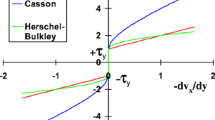Conclusions
A complex mathematical model of plastic flow of compressible materials is described. The model is versatile and, in the authors' opinion, free from many of the drawbacks of earlier models [9–11]. In particular, it can readily be adapted to analysis of virtually any process of plastic working under conditions of axisymmetric deformation; it enables all mechanical and temperature boundary conditions to be exactly fulfilled in all parts of the boundary S of a plastic flow region; it can be used for studying nonsteady-state processes of plastic working of metals with seats of deformation of complex shape (e.g., axisymmetric forging); it makes it possible to introduce starting data and extract resultant information in a form convenient to the user (production engineer).
Similar content being viewed by others
Literature cited
V. S. Smirnov, N. N. Pavlov, and S. E. Vinogradov, “Use of Lagrange's variational principle in problems on the plastic working of metal powders,” in: Plastic Working and Welding of Metals [in Russian], Mashinostroenie, Leningrad (1970), pp. 15–18.
G. Ya. Gun, Theoretical Principles of Plastic Working of Metals [in Russian], Metallurgiya, Moscow (1980).
M. B. Shtern, “Determining equations for compressible plastic porous solids,” Poroshk. Metall., No. 4, 17–23 (1981).
A. Ya. Gun, “Realization of a conformal representation of a curvilinear tetragon on a rectangle by a finite-element method,” Teor. Tekhnol. Deformatsii Met., No. 145, 12–17 (1982).
A. A. Samarskii, Theory of Difference Schemes [in Russian], Nauka, Moscow (1977).
G. Ya. Gun, Mathematical Modeling of Processes of Plastic Working of Metals [in Russian], Metallurgiya, Moscow (1983).
O. Zienkiewicz, Finite-Element Method in Engineering [Russian translation], Mir, Moscow (1975).
O. V. Roman, E. V. Zvonarev, L. D. Velyuga, et al., “Moire method of investigation of the stress-strain state of sintered porous blanks in stamping,” Poroshk. Metall., No. 10, 7–13 (1980).
P. I. Polukhin, G. Ya. Gun, A. A. Frolov, et al., “Phenomenological theory of pressing of P/M materials in closed dies,” Teor. Tekhnol. Deformatsii Met., No. 119, 5–8 (1979).
G. Ya. Gun, S. A. Stebunov, D. Yu. Ganelin, et al., “Computer modeling and investigation of the process of rolling of porous materials,” Poroshk. Metall., No. 11, 21–26 (1983).
G. L. Petrosyan, G. G. Nersesyan, and S. S. Avetyan, “Finite-element method of investigation of the stress—strain state in the axisymmetric compression of porous materials,” Izv. Akad. Nauk Arm. SSR, Mekh.,33, No. 1, 65–76 (1980).
Author information
Authors and Affiliations
Additional information
Translated from Poroshkovaya Metallurgiya, No. 5(281), pp. 18–24, May, 1986.
Rights and permissions
About this article
Cite this article
Gun, G.Y., Gun, A.Y. & Gudkov, V.N. A complex mathematical model of processes of plastic flow of compressible materials. Powder Metall Met Ceram 25, 370–374 (1986). https://doi.org/10.1007/BF00813947
Received:
Issue Date:
DOI: https://doi.org/10.1007/BF00813947




